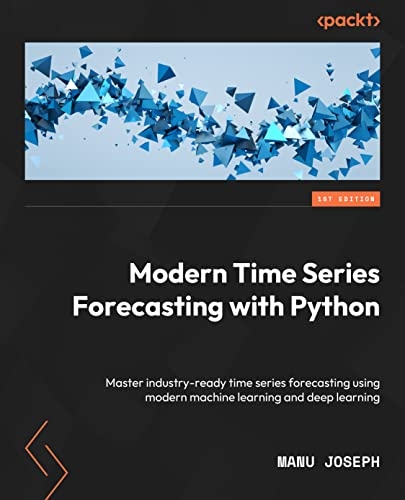Modern Time Series Forecasting with Python Explore industry-ready time series forecasting using modern machine learning and deep learning by Manu Joseph

1 Introducing Time Series
Welcome to Advanced Time Series Analysis Using Python! This book is intended for data scientists or
machine learning (ML) engineers who want to level up their time series analysis skills by learning new
and advanced techniques from the ML world. Time series analysis is something that is commonly
overlooked in regular ML books, courses, and so on. They typically start with classification, touch
upon regression, and then move on. But it is also something that is immensely valuable and ubiquitous
in business. As long as time is one of the four dimensions in the world we live in, time series data
is all-pervasive.
Analyzing time series data unlocks a lot of value for a business. Time series analysis isn't new—it's
been around since the 1920s and 1930s. But in the current age of data, the time series that are
collected by businesses are growing larger and wider by the minute. Combined with an explosion in
the quantum of data collected and the renewed interest in ML, the landscape of time series analysis
also changed considerably. This book attempts to take you beyond classical statistical methods such
as AutoRegressive Integrated Moving Average (ARIMA) and introduce to you the latest techniques
from the ML world in time series analysis.
We are going to start with the basics and quickly scale up to more complex topics. In this chapter,
we're going to cover the following main topics:
• What is a time series?
• Data-generating process (DGP)
• What can we forecast?
• Forecasting terminology and notation
Technical requirements
You will need to set up the Anaconda environment following the instructions in the Preface of the book
to get a working environment with all the packages and datasets required for the code in this book.
The associated code for the chapter can be found at https://github.com/PacktPublishing/Modern-Time-Series-Forecasting-with-Python-/tree/main/notebooks/Chapter01.
What is a time series?
To keep it simple, a time series is a set of observations taken sequentially in time. The focus is on the
word time. If we keep taking the same observation at different points in time, we will get a time series.
For example, if you keep recording the number of bars of chocolate you have in a month, you'll end
up with a time series of your chocolate consumption. Suppose you are recording your weight at the
beginning of every month. You get another time series of your weight. Is there any relation between
the two time series? Most likely, yeah. But we can analyze that scientifically by the end of this book.
A few other examples of time series are the weekly closing price of a stock that you follow, daily rainfall
or snow in your city, or hourly readings of your heartbeat from your smartwatch.
Types of time series
There are two types of time series data, as outlined here:
• Regular time series: This is the most common type of time series where we have observations
coming in at regular intervals of time, such as every hour or every month.
• Irregular time series: There are a few time series where we do not have observations at a
regular interval of time. For example, consider we have a sequence of readings from lab tests
of a patient. We see an observation in the time series only when the patient heads to the clinic
and carries out the lab test, and this may not happen in regular intervals of time.
Important note
This book only focuses on regular time series, which are evenly spaced in time. Irregular time
series are slightly more advanced and require specialized techniques to handle them. A couple
of survey papers on the topic is a good way to get started on irregular time series and you can
find them in the Further reading section of this chapter.
Main areas of application for time series analysis
There are broadly three important areas of application for time series analysis, outlined as follows:
• Time series forecasting: Predicting the future values of a time series, given the past values—for
example, predict the next day's temperature using the last 5 years of temperature data




